|
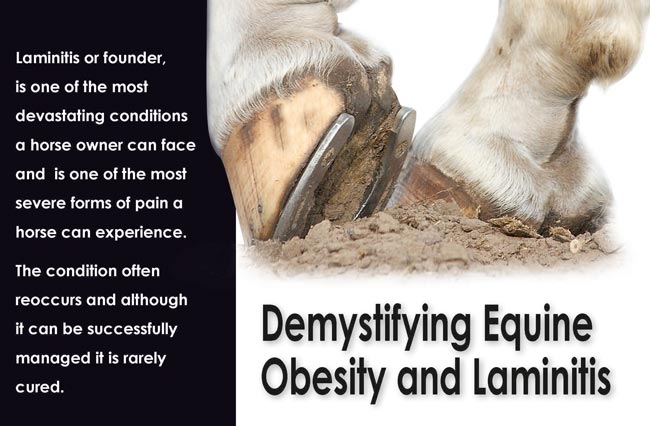
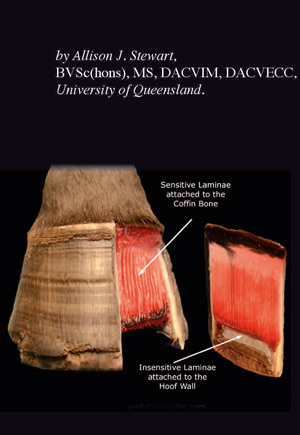 Laminitis means inflammation of the laminae; those tiny interdigitating regions that adhere the sensitive and non-sensitive areas of the hoof. It presents in varying forms, from mild through to severe. Laminitis means inflammation of the laminae; those tiny interdigitating regions that adhere the sensitive and non-sensitive areas of the hoof. It presents in varying forms, from mild through to severe.
MILD
This can result in a slight lameness that is worse when turning on hard ground. Frequently these animals will shift their weight from one foot to the other to gain some relief. There is usually pain over the toe and middle of the sole when hoof testers are used by a veterinarian or farrier.
MODERATE
With moderate laminitis an animal appears to be ‘walking on egg-shells’, often with the hind feet extended under the belly to take some weight off the more severely affected feet. A horse can be reluctant to even pick up its feet and, before any corrective front trimming, desensitising nerve blocks may be required to be performed by a veterinarian.
SEVERE
In its severest form the horse often lays down and refuses to get up. It may have elevated heart and respiratory rates and decreased appetite just from the pain.
If you imagine how painful it is to bend back a fingernail or have a fingernail ripped off, then imagine standing on four such fingernails. Now imagine that you weigh as much as a horse.
The pain is caused by the separation of the sensitive and insensitive laminae, that bond the hoof wall to the hoof, which can result in rotation of the coffin/pedal bone or even sinking of the bones and sensitive foot structures inside the hoof capsule.
In its worst form, the pedal bone can protrude through the sole of the hoof or the hoof can even completely separate from the sensitive lamellae and a horse can walk out of its hooves.
Frequently they are then suddenly more comfortable, but this is usually an indication for immediate euthanasia or aggressive heroic care for over a year in a specialist equine veterinary hospital facility.
Treatment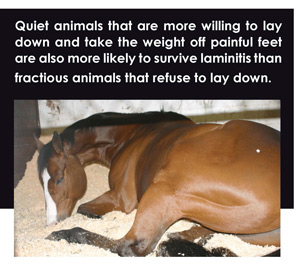
Treating a horse with severe laminitis is one of the saddest and most difficult situations a veterinarian can face. With intensive care, whole body support, high level pain control and exemplary farrier care, some of the most severe cases regrow new hooves and become breeding animals or pasture pets, and even those with severe rotation and sinking return to athletic performance. However, it is a long and expensive road and there is never a guarantee of ultimate success.
Because of their small size ponies tend to recover much better than larger horses.
The Difficult Decision
The decision to euthanise a horse depends on the clinical and radiographic severity of the laminitis, financial limitations, intended use, size and temperament. It is a difficult decision and there have been horses that were at the point of euthanasia - but whose owners insisted on giving them more time - that did eventually make it. There was a 3-day event Thoroughbred gelding with horrendous diarrhoea from salmonella and severe laminitis in all four feet- with 30 degree rotation. After a week of intensive care and then a year of rest and careful trimming the horse was sound; hooves were radiographically normal and the horse allowed to return to work.
Another very smart Quarter Horse broodmare with a foal at foot was lying down for over a week with a high heart rate and difficult to control pain. She continued to eat and drink and nurse the foal whilst laying on her side in an immaculately clean, very well-padded stall and was maintained on a cocktail of intravenous pain killers. One day someone left the stable door open and she got up and trotted off down the drive to eat some grass and eventually made an uneventful recovery.
Euthanasia and how far to go with treatment of these animals is a very individual decision. Advanced diagnostic imaging and even blood perfusion studies using radiographic imaging can be helpful to guide prognosis and treatment.
Unfortunately a horse only appreciates its current painful situation and it can not comprehend that it has a 30 or 50 or 80% chance of improvement and long term survival.
It can be very difficult to predict which of the severe cases will be successful. It is also not uncommon to see the old pony who suffers frequent bouts of laminitis being left down the back paddock, untreated and untrimmed. Some of these ponies hobble around for years and their hooves grow into pixie slippers as the heals grow faster 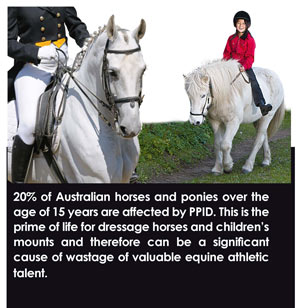 than the toes. These cases are also unbearably sad. than the toes. These cases are also unbearably sad.
Common cause - hormonal imbalance
Endocrinopathic laminitis is the most common cause of laminitis and is due to hormonal imbalance, and is predisposed by genetics and frequently influenced by diet. Pituitary pars intermedia dysfunction (PPID) used to be called Equine Cushing’s syndrome as the basis is somewhat similar to an endrocrine disease in humans and dogs. However, there are many differences, thus the condition in equids has been renamed PPID.
PPID is rarely diagnosed in horses less than 12 years of age. Unfortunately it is frequently unrecognised by owners in the early stages and therefore left untreated. Educating owners to recognise the early clinical signs, or annual geriatric veterinary examinations, can help promptly diagnose the condition.
A growth in the pituitary gland (a hormone-producing gland at the base of the brain) produces excessive hormones including adrenocorticotropic hormone (ACTH). The hormonal imbalance causes the clinical signs and it appears the horse is constantly preparing for winter! In end-stage disease there is usually a characteristic long, curly hair coat.
Other classic signs include delayed hair coat shedding in the spring; weight loss; frequent urination; laminitis (founder) or recurrent infections such as foot abscesses, skin infections or pneumonia. Most of PPID cases (90%) have the characteristic hair coat changes, but some only have laminitis or other clinical signs at the time of diagnosis. Other signs include bulging fat pads above the eyes, obesity, loss of top-line, pendulous belly, bowed suspensory tendons and infertility. Sometimes, the first signs are increased whispy hairs under the chin or a delay in shedding the winter coat. With mild, low-grade laminitis there may be growth rings observed on the hooves.
Causes of laminitis:
1: Support limb laminitis- the opposite limb founders when taking most of the weight whilst recovering from severe tendon injuries or fractures of the opposite leg.
2: Road founder from galloping on a very hard surface.
3: Laminitis secondary to severe illness seen in horses with colic, diarrhoea, pneumonia or frequently in mares that retain their placenta for more than 4 hours.
4: Endocrinopathic laminitis- this is the most common form from hormonal imbalance and will be discussed in detail below.
5: Grain overload - when a horse breaks into the feed shed and eats
grain or even cattle or chicken feed. These animals become very sick and the laminitis is similar to that described in 3. If a horse has gorged itself on grain it is an absolute immediate
veterinary emergency.
6: Grass founder- usually secondary to endocrinopathic laminitis, but occasionally simply from too many calories and a situation similar to 5.
Testing for PPID
The condition is easily diagnosed by a blood test (ACTH concentration) in horses with marked clinical signs, but most equine internal medicine specialists now offer a more sensitive testing procedure (ACTH response to TRH stimulation) to help detect early disease where clinical signs are vague. This test is usually only available at referral hospitals. There is a seasonal increase in ACTH concentrations in all horses with decreasing day length (autumn months). This is mild in normal horses, but severe in horses with PPID. It is essential that the laboratory provide the veterinarian with seasonal reference ranges for their geographic location. If seasonal reference ranges are used, then testing in March is the most sensitive time of the year to detect abnormal ACTH concentrations in horses with mild PPID. Annual testing of much loved or valuable animals over 16 years is recommended. Early diagnosis enables treatment to help prevent some of the devastating consequences of PPID such as laminitis.
Daily treatment with a drug called pergolide is required to control clinical signs, but many geriatric horses can become useful athletes again with adequate, successful treatment.
Annual blood tests are recommended to ensure that the condition is being adequately treated. Often horses need an increasing dose of pergolide as they age to keep hormone concentrations normal and control clinical signs. If your PPID horse is still hairy, his dosage of pergolide is probably not adequate. Many horses with PPID also have insulin dysregulation or Equine Metabolic Syndrome (EMS) and require special low-sugar diets
Cause - insulin resistance
Endocrinopathic laminitis - Equine metabolic syndrome (EMS)
Most horse owners know that fat horses are more likely to founder, with many believing it is just too much rich grass, however there are many obese horses that do not founder and some leaner animals that have recurrent bouts of laminitis, especially when the grass is richest. Insulin dysregulation is the primary cause and the condition is similar to type 2 diabetes in people.
Insulin is a hormone that is produced by the pancreas in response to a meal (especially a grain or high-sugar grass or hay). Insulin binds to insulin receptors and helps drive the glucose from the blood into the cells of the muscles and liver. However, if the insulin receptors are not functioning properly, then insulin concentrations may rise in response to feeding, which is called insulin resistance or insulin dysregulation. Animals that have elevated insulin concentrations are more likely to develop laminitis when fed high sugar feeds.
There is a genetic predisposition to insulin resistance associated with ‘thriftiness’. Ponies evolved to live on poor quality feeds in harsh environments - i.e. the islands of Scotland and craggy mountains of Wales - which was beneficial in times of limited feed and cold, stormy weather. However, in the Australian domestic situation where feed is often plentiful and pastures are improved then insulin resistance can lead to laminitis. Horses with EMS can be either obese or have a normal body condition, but have abnormal deposits of fat in their crest, sheath, shoulders and rump.
Body condition
It is important to carefully monitor body condition score (BCS) in all animals. Using a 6 point scale: 0 is emaciated, 1 is starving, 2 is thin, 3 is perfect (lean), 4 is fat and 5 is obese. When we see an animal in BCS 1, then we may feel compelled to report the situation to the RSPCA. However, an animal that has a BCS of 5 is in just as poor health. In fact, if this obese animal founders it will likely have lifelong hoof damage, while the BCS 1 horse will likely have no long term consequences.
There is a cresty neck score where 0 is a ewe neck, 1 is a flat neck, 2 is a slight crest (healthy), 3 is a moderate crest, 4 is a bulging, hard cresty neck, and 5 is a grossly bulging hard neck that may have fallen to the side. EMS horses frequently have a cresty neck score of 3, 4 or 5 and warrant investigations of insulin concentrations as they may be at risk of laminitis. 
A simple but reliable on-farm method to test insulin status is to fast the animal for 6-8 hours then administer either in feed (oaten or lucerne chaff) or by syringe or stomach tube 0.75 g per kg body weight of dextrose powder. After two hours, a single blood sample is drawn and serum insulin concentrations are measured at the laboratory.
As so many ponies are genetically predisposed to EMS they are at extreme risk of laminitis if allowed to get too fat or if they consume too much sugar through grain, lush grass or quality grass hays with a high sugar content.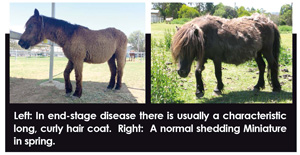
Unfortunately, there is an expectation that ponies and horses be in a body condition score (BCS) of 4 for success in the show ring, and many have shortened athletic careers due to the devastating effects of laminitis after being overfed in preparation for the show season.
Anorexia is so common in girls and young women aspiring to such an unhealthy body weight, but we are doing just as much harm to our show horses. So how can we save our horses and ponies from horrendously painful laminitis? I truly believe it is primarily up to our show judges. At the recent Victorian APSBS Stud Show a Scottish judge heavily penalised ponies he considered to be too fat. From a medical point of view I applaud such decisions. A BCS of 3 is medically ideal, yet frequently such horses and ponies are discriminated against in the show ring for looking too lean and “like a Thoroughbred racehorse”.
We need to re-educate horse owners and judges that a BCS of 3 or 3.5 is healthy and ideal.
Show condition is generally a BCS of 4, with some animals being shown in BCS 4.5. Although it is certainly easier to hide minor conformational faults in an overweight animal with BCS of 4 or above, does the ribbon really outweigh the risks? 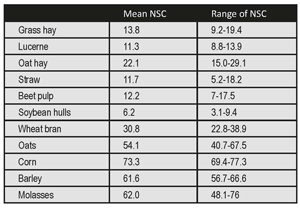
Safe feeding
If animals are a BCS of 4 or above they need calorie restriction. An average horse requires approximately 2% of its body weight in hay per day, but this obviously varies based on the metabolic efficiency of the animal and the quality of the hay. For weight loss, only 1% of body weight in hay is required. For horses and ponies that have EMS and are not obese, weight loss may not be required, but as these animals are intolerant of high-sugar feeds due to their insulin resistance, the type of feed selected is just as important as the amount. Sugar content of feeds is determined by measuring non-structural carbohydrate (NSC) content and a value less than 10 is ideal for EMS patients. As can be seen in the table on left, grass hay is commonly well above an NSC of 10. If grass hay is fed to EMS equids then it should be tested (feed.test@agrifood.com.au, www.sgs.com.au) or purchased as low glycaemic certified hay.

Pasture grass is the greatest risk for EMS patients as it has the same high NSC as grass hay and it is impossible to appreciate just how much a pony can consume in 24 hours. On lush improved grass pastures a pony can consume enough grass to fuel a racehorse in just 3 hours! Horses and ponies are extremely efficient grazers and even on very short grass there may not appear to be any feed in the pasture, but in keeping that pasture so short the animal is still often consuming a vast amount of grass. Pasture is the inciting cause of many episodes of laminitis and some animals can not tolerate any pasture. If pasture turnout is allowed, it may need to be limited to less than 1 hour per day or with the use of a grazing muzzle. Ponies are smart, and the shorter the period of turnout, the faster they will eat!
Obviously any grains such as oats, corn, barley and even wheat bran or oaten hay, should never be fed to an EMS patient. Lucerne is actually one of the safest feeds. For weight gain, beet pulp, soyabean hulls, rice bran and vegetable or sunflower oil can be safely fed.
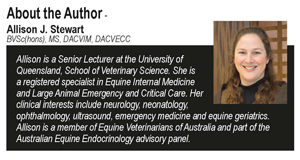
|